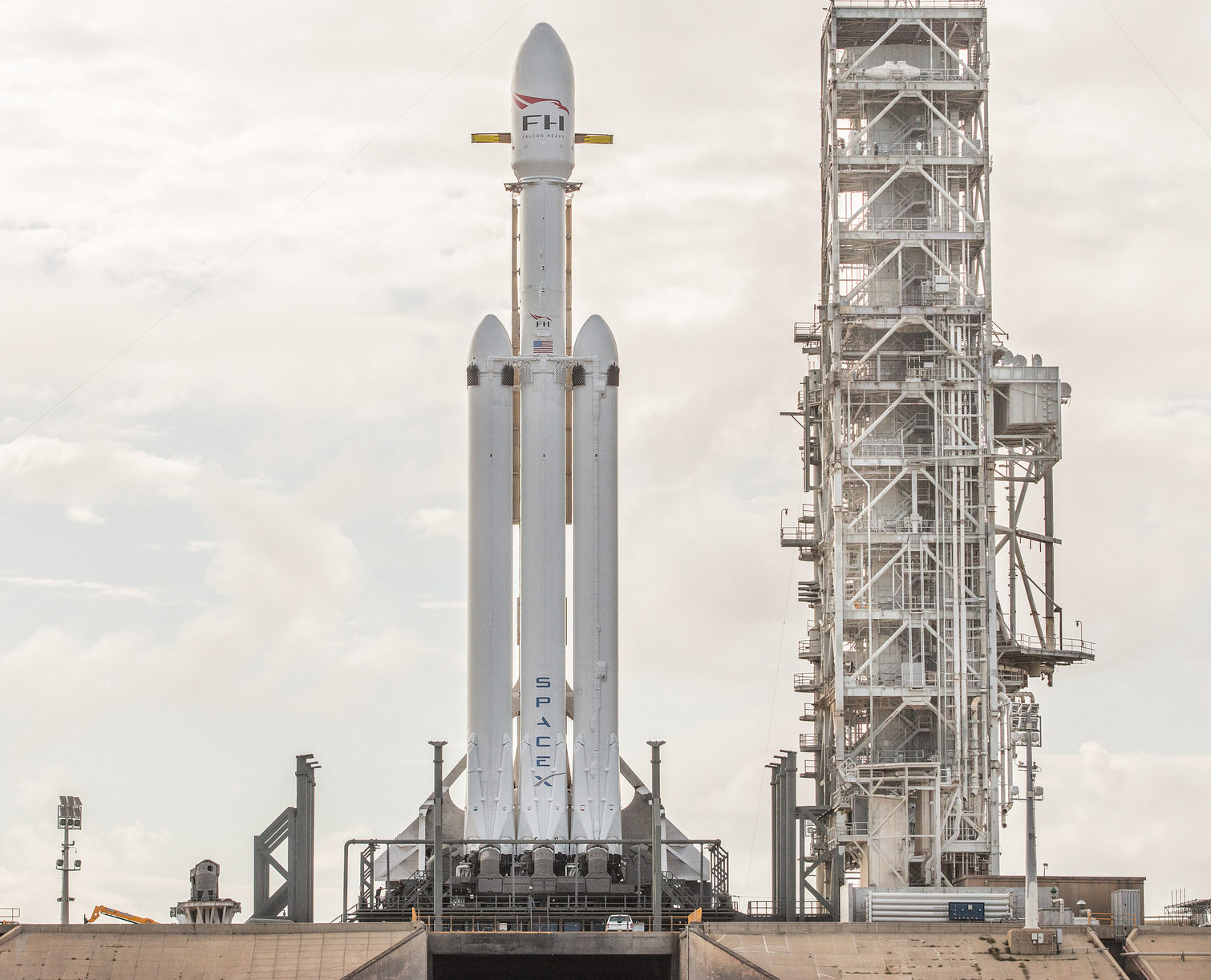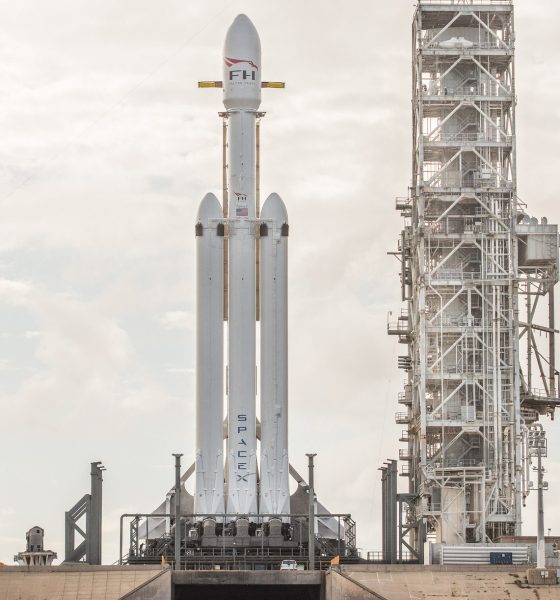

News
Best places to watch SpaceX’s Falcon Heavy launch
Just a day away from SpaceX’s first inaugural Falcon Heavy launch attempt on February 6 at 1:30 pm EST, hype for the triple-rocket is reaching a boiling point, and for good reason. Already, there are hints and reports that the launch is likely to draw crowds not seen in several years, likely well over 100,000 people. This means that those still interested in viewing the historic launch but not yet committed may have trouble gaining access to the most popular viewing locations in Florida, but there are still a number of ways to join in on the spectacle.

SpaceX’s massive Falcon Heavy seen at Pad 39A ahead of its first successful static fire test. (Tom Cross)
Launch photographers and committed spaceflight fans are by far the best resources in this regard, and many have decades of experience viewing all kinds of rocket launches from Cape Canaveral, Florida. Prominent photographer Ben Cooper has created a brief launch viewing guide specific to Falcon Heavy, the size of which means that certain viewing sites are either closed or already sold out. Quoted below, he provides a solid summary of the options still available to fans and travelers alike:
Falcon Heavy / [No Earlier Than] Feb 6 @ 1:30pm (Pad 39A):
1) If you are heading to PLAYALINDA BEACH (3.6 miles at first parking lot, closest possible spot to watch this launch): They plan to remain open, but the park reserves the right to change that, alter traffic patterns, and close beaches/areas when parking lots are filled. The beach opens at 6:00am. GET THERE EARLY AND HAVE A BACKUP PLAN. THEY MAY CLOSE UPON REACHING PARKING CAPACITY. Plan for the possibility of having to walk between one and three miles from where you park if you wish to get closer.
2) The Kennedy Space Center Visitor Center (KSCVC) is also selling tickets: Saturn V Center (3.9 miles) tickets are SOLD OUT. Tickets to go to the Visitor Complex itself were still available as of Feb. 1 (7.4 miles; you will see the launch and landing only in the sky; the pads are behind the trees). (They are also selling $35 tickets to watch from a location in Titusville which you otherwise go to for free.)
3) Next best for launch only: Titusville riverfront areas (any), but especially on top of the Max Brewer Bridge (11.7 miles, Rt. 406/Garden Street).
4) Next best for launch + landings both: Port Canaveral (Rt. 401, 6.9 from landings, 13 from launch) or Jetty Park (6.0 from landings but no view of launch pad). If 401 is filled or no more parking is allowed, fall back to Rt 528/Beeline behind it.
If you’re looking for a far more populated map including public transport, airports, rest stops, nearby amenities, and more, LaunchRats.com has you covered. They also feature a Falcon Heavy viewing guide, but Ben’s above guide is nearly identical. For a full rundown of the above resources and much, much more, Tim “Everyday Astronaut” Dodd has crafted an extremely well-made video walking viewers through all they need to know ahead of attempting to watch rocket launches in Florida, and I highly recommend it if you have ten or so minutes to spare.
As he rightly points out, Falcon Heavy viewing guides effectively work for all launches Florida, albeit minus any rocket landing attempts in the case of NASA or ULA missions. In the case of Falcon Heavy, not one but two of its three first stages will be attempting landings at Landing Zone 1, guaranteed to produce a visual spectacle from several of the aforementioned viewing locations, as well as a symphony of sonic booms (probably six or more) throughout the East coast of Florida. Buckle up, it’s bound to be a moment to remember, one way or another. For those that can’t attend the launch in person, SpaceX will undoubtedly provide their own exceptional live coverage.
Follow along live as launch photographer Tom Cross covers this incredible moment in person, documenting all of the best parts on Teslarati’s Instagram stories. Up next is the release of be a Falcon Heavy launch animation straight from SpaceX.
Teslarati – Instagram – Twitter
Tom Cross – Instagram
Eric Ralph – Twitter

Elon Musk
Starlink passes 9 million active customers just weeks after hitting 8 million
The milestone highlights the accelerating growth of Starlink, which has now been adding over 20,000 new users per day.

SpaceX’s Starlink satellite internet service has continued its rapid global expansion, surpassing 9 million active customers just weeks after crossing the 8 million mark.
The milestone highlights the accelerating growth of Starlink, which has now been adding over 20,000 new users per day.
9 million customers
In a post on X, SpaceX stated that Starlink now serves over 9 million active users across 155 countries, territories, and markets. The company reached 8 million customers in early November, meaning it added roughly 1 million subscribers in under seven weeks, or about 21,275 new users on average per day.
“Starlink is connecting more than 9M active customers with high-speed internet across 155 countries, territories, and many other markets,” Starlink wrote in a post on its official X account. SpaceX President Gwynne Shotwell also celebrated the milestone on X. “A huge thank you to all of our customers and congrats to the Starlink team for such an incredible product,” she wrote.
That growth rate reflects both rising demand for broadband in underserved regions and Starlink’s expanding satellite constellation, which now includes more than 9,000 low-Earth-orbit satellites designed to deliver high-speed, low-latency internet worldwide.
Starlink’s momentum
Starlink’s momentum has been building up. SpaceX reported 4.6 million Starlink customers in December 2024, followed by 7 million by August 2025, and 8 million customers in November. Independent data also suggests Starlink usage is rising sharply, with Cloudflare reporting that global web traffic from Starlink users more than doubled in 2025, as noted in an Insider report.
Starlink’s momentum is increasingly tied to SpaceX’s broader financial outlook. Elon Musk has said the satellite network is “by far” the company’s largest revenue driver, and reports suggest SpaceX may be positioning itself for an initial public offering as soon as next year, with valuations estimated as high as $1.5 trillion. Musk has also suggested in the past that Starlink could have its own IPO in the future.
News
NVIDIA Director of Robotics: Tesla FSD v14 is the first AI to pass the “Physical Turing Test”
After testing FSD v14, Fan stated that his experience with FSD felt magical at first, but it soon started to feel like a routine.

NVIDIA Director of Robotics Jim Fan has praised Tesla’s Full Self-Driving (Supervised) v14 as the first AI to pass what he described as a “Physical Turing Test.”
After testing FSD v14, Fan stated that his experience with FSD felt magical at first, but it soon started to feel like a routine. And just like smartphones today, removing it now would “actively hurt.”
Jim Fan’s hands-on FSD v14 impressions
Fan, a leading researcher in embodied AI who is currently solving Physical AI at NVIDIA and spearheading the company’s Project GR00T initiative, noted that he actually was late to the Tesla game. He was, however, one of the first to try out FSD v14.
“I was very late to own a Tesla but among the earliest to try out FSD v14. It’s perhaps the first time I experience an AI that passes the Physical Turing Test: after a long day at work, you press a button, lay back, and couldn’t tell if a neural net or a human drove you home,” Fan wrote in a post on X.
Fan added: “Despite knowing exactly how robot learning works, I still find it magical watching the steering wheel turn by itself. First it feels surreal, next it becomes routine. Then, like the smartphone, taking it away actively hurts. This is how humanity gets rewired and glued to god-like technologies.”
The Physical Turing Test
The original Turing Test was conceived by Alan Turing in 1950, and it was aimed at determining if a machine could exhibit behavior that is equivalent to or indistinguishable from a human. By focusing on text-based conversations, the original Turing Test set a high bar for natural language processing and machine learning.
This test has been passed by today’s large language models. However, the capability to converse in a humanlike manner is a completely different challenge from performing real-world problem-solving or physical interactions. Thus, Fan introduced the Physical Turing Test, which challenges AI systems to demonstrate intelligence through physical actions.
Based on Fan’s comments, Tesla has demonstrated these intelligent physical actions with FSD v14. Elon Musk agreed with the NVIDIA executive, stating in a post on X that with FSD v14, “you can sense the sentience maturing.” Musk also praised Tesla AI, calling it the best “real-world AI” today.
News
Tesla AI team burns the Christmas midnight oil by releasing FSD v14.2.2.1
The update was released just a day after FSD v14.2.2 started rolling out to customers.

Tesla is burning the midnight oil this Christmas, with the Tesla AI team quietly rolling out Full Self-Driving (Supervised) v14.2.2.1 just a day after FSD v14.2.2 started rolling out to customers.
Tesla owner shares insights on FSD v14.2.2.1
Longtime Tesla owner and FSD tester @BLKMDL3 shared some insights following several drives with FSD v14.2.2.1 in rainy Los Angeles conditions with standing water and faded lane lines. He reported zero steering hesitation or stutter, confident lane changes, and maneuvers executed with precision that evoked the performance of Tesla’s driverless Robotaxis in Austin.
Parking performance impressed, with most spots nailed perfectly, including tight, sharp turns, in single attempts without shaky steering. One minor offset happened only due to another vehicle that was parked over the line, which FSD accommodated by a few extra inches. In rain that typically erases road markings, FSD visualized lanes and turn lines better than humans, positioning itself flawlessly when entering new streets as well.
“Took it up a dark, wet, and twisty canyon road up and down the hill tonight and it went very well as to be expected. Stayed centered in the lane, kept speed well and gives a confidence inspiring steering feel where it handles these curvy roads better than the majority of human drivers,” the Tesla owner wrote in a post on X.
Tesla’s FSD v14.2.2 update
Just a day before FSD v14.2.2.1’s release, Tesla rolled out FSD v14.2.2, which was focused on smoother real-world performance, better obstacle awareness, and precise end-of-trip routing. According to the update’s release notes, FSD v14.2.2 upgrades the vision encoder neural network with higher resolution features, enhancing detection of emergency vehicles, road obstacles, and human gestures.
New Arrival Options also allowed users to select preferred drop-off styles, such as Parking Lot, Street, Driveway, Parking Garage, or Curbside, with the navigation pin automatically adjusting to the ideal spot. Other refinements include pulling over for emergency vehicles, real-time vision-based detours for blocked roads, improved gate and debris handling, and Speed Profiles for customized driving styles.








